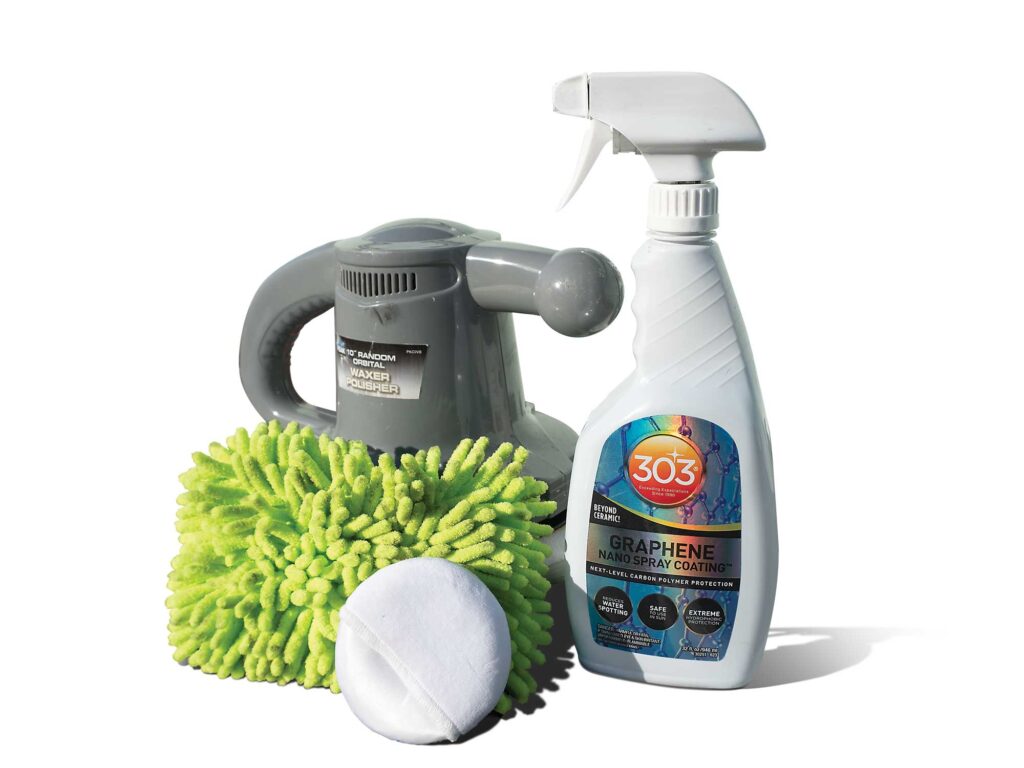
Boat wax is passe. If you want a truly hardshell shine, look to a new surface treatment called graphene. If you’ve selected a brand that is true graphene—usually graphene oxide—and not just granulated graphite, which describes many false graphene products, it will provide outstanding UV protection and dissipate another enemy to your boat’s finish: heat.
We used 303 Graphene Nano Spray Coating ($34.99). It’s bottled to resemble a quick detailer, but don’t apply it like a detailer or you’ll add a dull gray scrim to your finish. Use it properly and it’s tougher than wax.
What Is It?
Chemically, graphene products are graphene oxide. Pure graphene is far harder to isolate and mass-produce. Graphene oxide is a derivative of graphite. It’s mechanically and chemically separated from graphite, yielding translucent molecular plates. The electrons of those plates are charged in such a way that they are attracted to each other. When suspended in another recently popular surface treatment, ceramic (which is silicon dioxide), they bond to each other and the hull surface in a tenacious honeycomb quilt that stops UV light, dissipates heat, sheds water, and protects hulls with a brilliant shine.
But don’t underestimate the note in the directions that the application surface must be “free of defects.” There should be no dirt and zero oxidation. Scratches need to be buffed out, and any road grease, polish residue or impurities must be removed or the graphene oxide will collect on such areas in excess, amplifying the flaws rather than hiding them, and adding a gray film to the hull.
Does it work? Oh yeah, it works. Here’s how.
Clean the Hull
Wash the hull thoroughly. Against popular judgment, I used Dawn dish detergent for its grease-cutting capability; I wanted no chance of boat-soap wax left over. I wiped it dry to stop water spotting. Next, I sprayed on a product used when we ceramic-coated my boat: Gtechniq’s Iron and Fallout Remover ($9.95; gtechniq.com). This chemical removes organic and metallic compounds, and turns purple when it’s finished.
Buff It to Death
After rinsing, I buffed out the hull with a three-step series of 303 polishes that graduated from Step No. 1 1500 grit to Step No. 2 2000 grit to Step No. 3 2500 grit (each $25.99 per 12-ounce bottle). Buy a buffer, unless you want your Mr. Miyagi treatment to end in a torn rotator cuff.
Graphene oxide is unforgiving and clearly amplifies any imperfections like oxidation or abrasions. This stuff wags a nasty tisk-tisk finger if you use shortcuts. Wipe the surface with a microfiber cloth between steps.
Panel Preparation
Once all the oxidation was gone, I turned to another product we used in our ceramic treatment: Gtechniq’s Panel Wipe ($19.95). This is primarily alcohol, and it quickly removes polish residue.
Wipe On, Swipe Off
Next, the 303 Graphene Nano Spray Coating has to be laid down in a thin layer. Multiple layers of graphene plates turn from translucent to opaque and tint the finish. You can buff it out, but you’ll cuss yourself for doing so.
Instead, spray it on a foam-backed microfiber pad. We received one from 303 that was about twice the size and thickness of a bar of soap. Wipe it on the hull in cross-hatch motions, back and forth, up and down, and repeat until it is evenly applied and barely visible.
Let it dry just a few minutes and wipe it off. Work in small patches for a mirrorlike finish that amplifies the quality of the surface below it.
Maintain the results with frequent washings using a wax-free boat soap. Or use 303 Graphene Detailer ($16.99) to make the hull match the gleam in your eye. As with all surface treatments, reapply it long before the manufacturer’s maximum life-limit recommendation. In other words, read “three to six months” as three months. It will be far less work that way.









